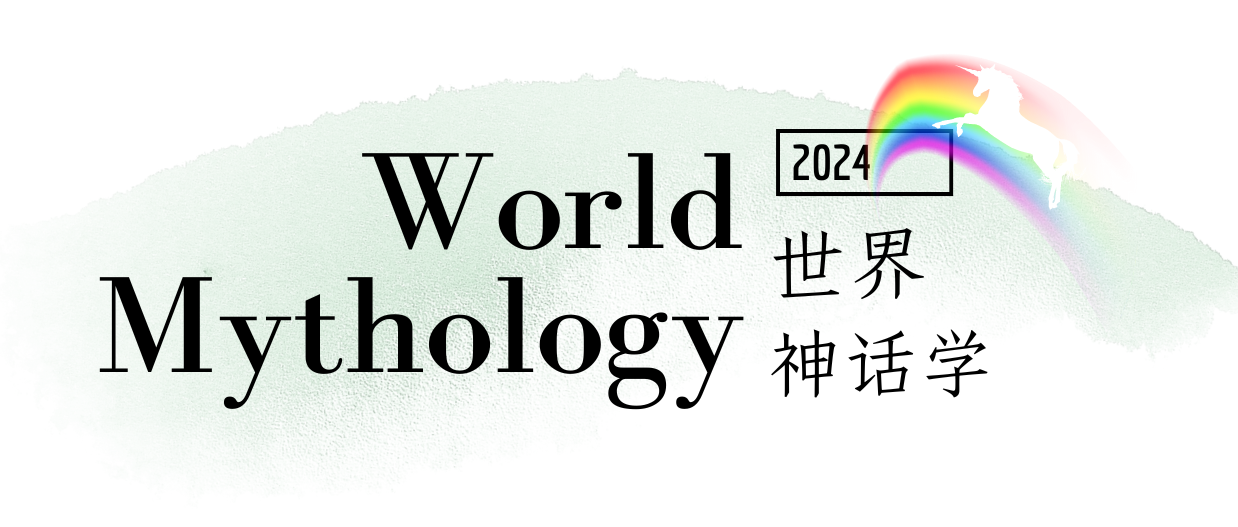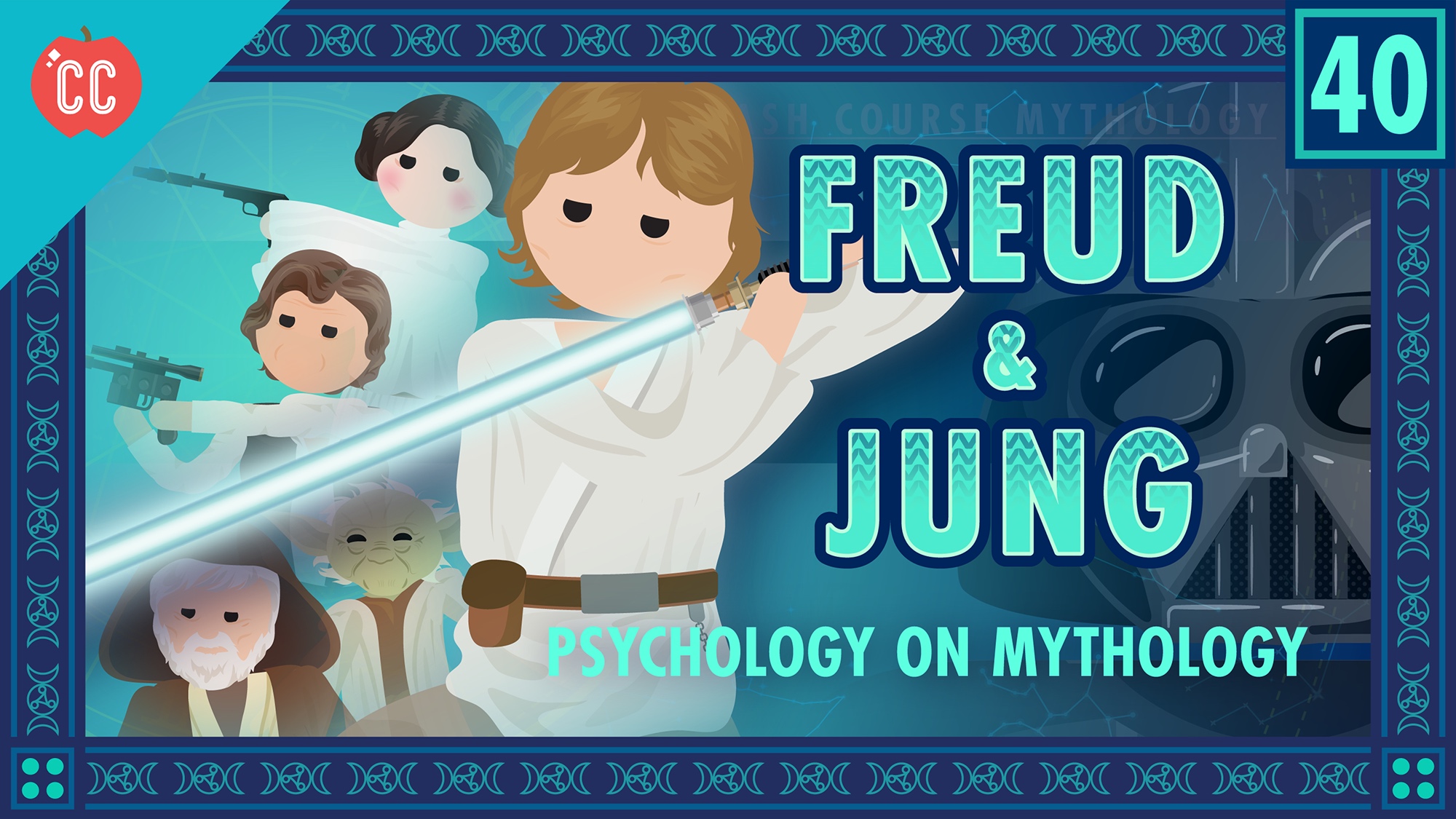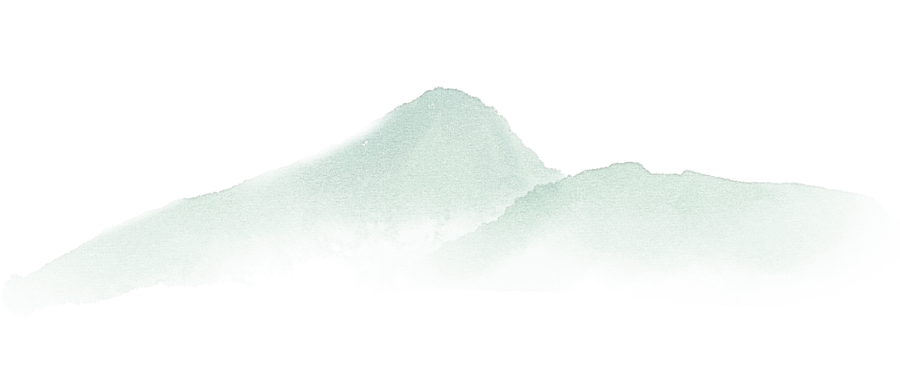




版权归Crash Course公开课所有,本文仅作读文学习使用,如侵权,请联系搬运工删除。
该本仅分段,未作精细校验,可能会出现单词错误,语义不详等问题。讲究读文体验的朋友也可等搬运工修订注释后再读。
(40)
Freud, Jung,
Luke Skywalker,
and the Psychology of Myth

Description
🌳 In which Mike Rugnetta teaches you about Sigmund Freud and Carl Jung, and how a lot of their work was influenced by myth and mythology. While Freud and Jung aren't quite as revered as they once were, they were undoubtedly a huge influence on the practice of psychology and psychiatry, and these two fellas were undoubtedly influenced by foundational stories. Today, we'll learn about Oedipus, the collective unconscious, archetypes, Star Wars, and more!
🌳
1. This is Crash Course Mythology and today we're going to lay mythology down on this comfy little couch over here and we're going to listen to all its problems. It's time to get all psychology on mythology.
We'll be examining the theories of both Sigmund Freud and Carl Jung, and discussing the curious relationship the works of both men have to mythology. So, Thoth, how do you feel about your mother? Oh, that's right, you created yourself. Or did you spring from Set's forehead? Or was it Ra's heart?
🌳
2. Anyway, we're talking about Freud and Jung for two main reasons. The first is that they used myths in their practice. They relied on ancient stories to describe the contemporary psychological conditions they observed and would often relate what their patients told them to mythological stories. And second, we can use some of their theories to explore and analyze myth itself, just like we applied Joseph Campbell's theories in our exploration of hero myths. And let's not forget that Campbell's theories owe a lot to Jung.
🌳
3. Freud and Jung were contemporaries and the two of them were hugely influential in establishing psychology and psychoanalysis in the 20th century. Freud started writing in the 1890s and is generally considered the father of psychoanalysis, which in turn, has influenced almost all of our pop culture representations of what psychology or therapy or even the mind look like. Freud and Jung both believed that our dreams - the stories that our minds create without our active input - were keys to understanding our waking selves and the problems we experience.
🌳
4. For a lot of his career, Freud thought that most of our problems had a single root: the Oedipus. You've probably heard the phrase "Oedipal complex." This is a classic and well-known example of how Freud was influenced by mythology.
He used the Greek myth of Oedipus to help illustrate a particular theory he had about why so many rich 19th century Viennese people were so neurotic. We've covered the myth in Crash Course Literature, but basically: Oedipus is a Greek prince who is a subject of a prophecy which says one day he will kill his father and marry his mother. He does everything he can to avoid this, only years later, to sort of accidentally kill his father, the king Laius, and sort of accidentally marry his mother, the Queen Jocasta. And then less accidentally sort of have a bunch of incest kids.
🌳
5. Freud borrowed Oedipus' name to help explain his theory that young boys have a natural desire to replace their fathers and bed their mothers. Freud argued that so many other hang-ups and emotions derive from this "complex." Now, maybe you're thinking: I don't want to sleep with my mother, or, I'm not a boy so how does this apply to me? And you would be right to have these questions; there are definitely some assumptions in a lot of Freud's theories. But like it or not, these theories have shaped and influenced huge swaths of twentieth century Western culture. And we haven't even talked about his theory of penis envy and - oh look at the time we better keep moving.
🌳
6. Carl Gustav Jung was, at one time, Freud's friend and collaborator. And like Freud, Jung is a towering figure in the history of psychology. One of his best-known techniques was a way of analyzing dreams. Jung believed that dreams could be understood through "archetypes." He defined archetypes as those figures or concepts that occur across cultures and history, shared, in essence amongst all people. "There are as many archetypes as there are typical situations in life," he once wrote. Jung believed archetypes helped us understand the world, and explain not only our dreams, but also the common aspects of dreams among many people.
🌳
7. According to Jung, human beings everywhere are born with the ability to draw archetypes from a sort of super-psychic ether, and form them into an individually useful language of storytelling and meaning. This ether is known as the collective unconscious, and is one potential explanation why there are so many commonalities in myths throughout the world.
🌳
8. Jung thought archetypes in dreams and stories alike were one key to better understanding our own lives. So if Jung used archetypes as a way to analyze dreams, he drew on myths depicted in stories and art to figure out what those archetypes were. Stories of heroes and witches and tricksters and maidens help inform the archetypes that Jung established, which he in turn used to explore the psychology of his patients. He considered a person's psyche to be an individual manifestation of elements taken from the collective unconscious, elements also often found in myth. By taking ideas from different myths and using their widely accepted meaning to look analytically at our dreams, we can better understand our own psyche. And if we want to, we can also plug some of Jung's ideas back into myths to better understand how they work.
🌳
9. Jung discussed a lot of archetypes, but we're going to focus on three big ones that he thought were part of every individual. If an individual, or a hero of a myth, can integrate them all successfully, it means a fusion between the conscious mind, the personal unconscious, and the collective unconscious, and that means, wait for it, an integrated self. You got that? And hey, fun bonus fact, this individuation isn't necessarily an end state. People can go through it numerous times.
🌳
10. The three archetypes we're looking at are the shadow, the anima/animus, and the self. The shadow is a part of our unconscious mind and represents all the parts of a person that they don't like to acknowledge. This includes less socially-acceptable emotions like rage, sexual desire, or survival instincts. Think of it as your hidden self. Sort of like a reverse image of your conscious self.
In dreams and myths though, the shadow is always the same gender as the protagonist or dreamer. Yeah, Jung has a tendency to break things down along gender lines and make a lot of assumptions based on those. Today, this can feel pretty anachronistic and pretty patriarchal, something to keep in mind while we learn about it.
🌳
11. Next, the anima or animus, archetypes that likewise comprise an aspect of the protagonist's self in their unconscious mind. Women have an animus which represents their male side, while men have an anima representing their female side. Both are aspects of the collective unconscious, avatars for gender essentialism, kind of. Jung didn't consider them artifacts of our specific relationships with family members of the opposite sex though, which can have an impact on us, but in a different way.
🌳
12. The anima and - mus, rather, represent a sort of negation, even more deeply held than what's represented by our shadow. For men, their anima personifies their "feminine" characteristics, like moodiness, intuition, and irrationality - yeesh, because obviously men are never irrational or moody. For women, the animus represents "male" qualities like aggression, ferocity, risk-taking, and according to one scholar of Jung, silent, obstinate evil ideas. Though the animus, they say, can also help women take action, speak out, and find wisdom... 'cause ladies need a lot of help with that kind of thing, I guess? Also yeesh.
🌳
13. The last archetype is the self. Not like your actual self, but a character that represents a total and timeless unification of your conscious and unconscious parts. So sort of a superego, but also your link to the collective unconscious, too. The self does a lot of work. The self will once again be the same gender as the, um, self. Typically it's a wise old man, sometimes called a senex for men and for women, a crone, although that term isn't as judgy as it sounds.
🌳
14. Having integrated our primitive self, represented by the shadow, and our emotional opposite, represented by the anima or animus, we have gained a greater awareness of our selves and our participation in the collective unconscious. The integration and awareness that the self represents is the point of the journey, whether it's a mythical journey or a psychological one. Once the hero, having passed all of their psychic trials, can accept and acknowledge the archetype of the self, he or she has gained a kind of maturity. The same could be true for each of us in the journey of our own lives.
So Jungian archetypes can seem... abstract. To make them feel more concrete, we're going to use them to retell a contemporary myth that almost all of us knows: Star Wars.
🌳
15. A long time ago, in a galaxy far, far away lived a young dreamer named Luke Skywalker. He begins his process of individuation in total boredom on a desolate planet devoid of meaning. Then into his life comes a Shadow, with and awesome black cloak, Darth Vader. Powerful and cruel, Darth Vader could be seen as representing the harsher, angrier, more animalistic emotions Luke will not let himself express. Not long after, Luke meets another Shadow, wearing an awesome black vest, in a dangerous bar. This shadow, named Han, is cocky, where Luke is unassuming, skilled at fighting, where Luke is a novice, and above all, worldly, where Luke is naive. Luke and Han don't get along at first. In fact, Luke finds many aspects of Han unpleasant, especially his selfishness, but eventually, the two come to respect each other, mainly once Luke acknowledges his own aggression and learns to control it.
🌳
16. Soon, Luke finds his Anima in the form of a powerful princess with rad hair. Initally, Princess Leia is an object of sexual desire for the young man, but she's also a guide, providing Luke with the motivation to leave his home, and she leads him to his Senex, Obi Wan Kenobi. Obi Wan helps Luke reconcile with his Anima, establishing a loving relationship with her. Later, an even more powerful Senex, Yoda, the small green Jedi master with odd sentence structure he meets. Both Senexes teach Luke the ways of the Force, an elemental power that pervades all places and all things. Once Luke can acknowledge the Shadow as a hidden part of himself, accept the Anima as his opposite Self, and accept the wisdom of the Senex in forming his Self self, only then does he achieve maturation by becoming a Jedi.
🌳
17. Who knew that Jung was so applicable to outer space? George Lucas did. Because as we mentioned in our first episode on the hero myth, Jung was a big influence on Joseph Campbell, who was a huge influence on George Lucas. Obviously the Star Wars movies are famous for lots of reasons, but maybe we can attribute some of their success to the ability to tap into something that we all share, something in the collective unconscious. In Luke Skywalker's transformation from a whiny little boy to a confident Jedi maybe we're able to recognize our own experience of growing up, though with more robots, probably.
🌳
18. They're not always perfect, but if we use Jung's tools as a starting place to analyze myths and other popular stories, we can start to see some of the deep structures that run from one to the next. Maybe we can also start to understand why certain myths endure and why these are stories we want to keep telling about our world, about ourselves, and of course, about our droids.
Next time, we wrap up Crash Course Mythology by taking a look at how the language of myth has found its way into everyday speech. Thanks for watching, we'll see you then.
To be continued…
未完待续…

编辑 / 美工 / 校对:🌿香草女巫🧪
搬运工说:本系列共 41 集,涉及到的单词、神话内容繁杂,故搬运工编辑添加音标、注解及对应的神话画作、图片,放便各位朋友读文理解。因校注、编辑均由搬运工一人完成,难免有疏漏错误,请反馈告知。欢迎各位朋友一起阅读学习。